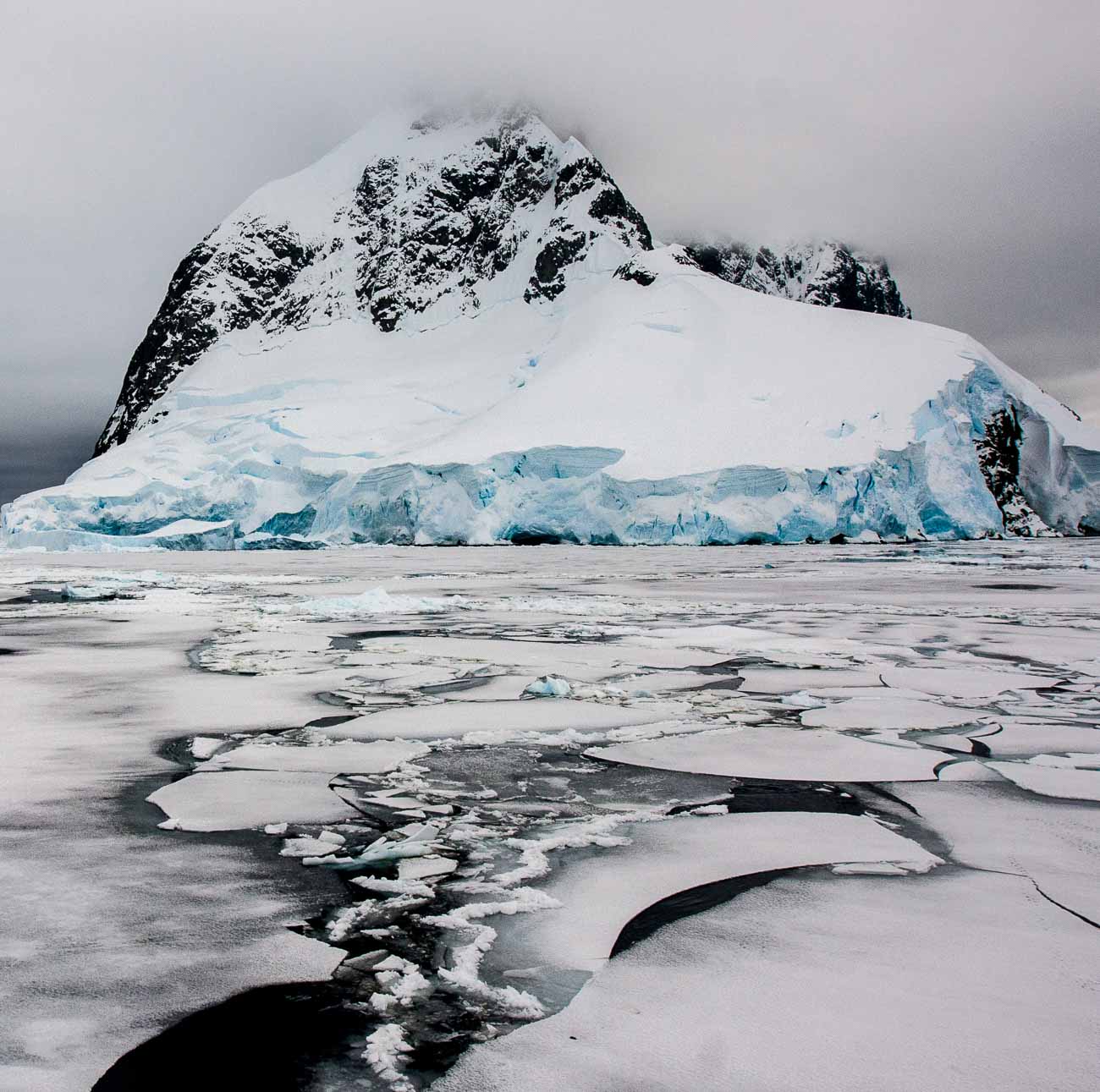
BE PREPARED FOR ANTARCTICA!
BE PREPARED FOR ANTARCTICA!
BE PREPARED FOR ANTARCTICA!
BE PREPARED FOR ANTARCTICA!
Be informed
99% of travelers to the Antarctic region visit the coastline of the white continent by ship, only 1% visit the interior of the continent (which requires traveling to Antarctica by plane). In practice, the size of the traveler’s wallet is the limiting factor, as taking a plane to travel inland tremendously increases the ticket’s price.
However, the real limiting factor is Antarctica itself!
The word “Antarctica” should be synonymous with adventure, pristine, remote and the end of the world. There is a simple reason for this: the environment is so harsh that even today, the climate there still dictates the rules. Men have not managed to be stronger than the environment in the Antarctic. Ice and weather tell us where, when and what to do. This is valid for the scientists and technicians working there, for politicians visiting these places and especially for travelers! You might be surprised to learn that people wintering in the heart of Antarctica are as isolated as the astronauts in the International Space Station!
As a matter of fact, you need to accept that going to Antarctica exposes you to several risks:
- first, you may never reach Antarctica. If any of your flights are delayed or cancelled, the ship or the plane departing for Antarctica is not going to wait for you. Unlike traditional tours, if you miss this departure, there is no second chance for you.
- the Southern Ocean is the roughest ocean on Earth. This is a fact. Its roughest waters are south of Australia, between Tasmania and the Ross ice shelf /Commonwealth Bay. Storms are frequent and this has a huge impact on your trip. Your departure could be delayed by a day or more, waiting for a storm to pass, before setting sail or taking off. You will therefore spend less days Antarctica than you anticipated. That’s why the number of days you spend in the Antarctic cannot be guaranteed. The strategy is the same on the way back from Antarctica: your departure day/time may be adjusted to avoid a storm.
- no one on the planet can guarantee the mechanical parts of a ship or an airplane. In some cases (very rare, but it does happen) if a mechanical problem occurs, it may have a huge impact on your trip: you might not reach your destination; or if you are already in Antarctica, half of the trip could be cancelled. This is done to ensure the safety of everyone onboard.
- each trip is different and unique. Essentially, each trip is ice, weather and wildlife dependent: if you were to make a hundred trips to Antarctica, with the same company and the same team, you will get a hundred different experiences and itineraries.
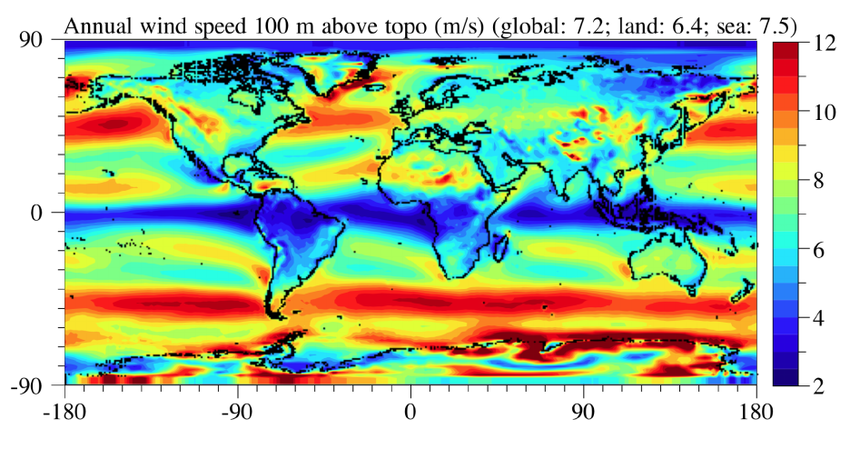 World average wind speed - Mark Z. Jacobson (researchgate.net).
World average wind speed - Mark Z. Jacobson (researchgate.net).Winds are actually reponsible of the formation of waves.
Be mentally prepared
The right mentality to adopt for a voyage to Antarctica is:
- never take for granted what is written on the brochure of your tour operator. Your trip might be extremely different, but it will still be incredible!
- do not compare what’s written in the program that your travel agent gave you to the experience that you will have in the field: no one can predict in advance where to find whales; where the sea ice will be; when storms are coming; when the swell will prevent you from going out from a ship; where crevasses will prevent you from reaching a summit; or when the winds are not appropriate for a landing.
- learn to be flexible and accept changes. Remove your watch and learn to be ready at a moment’s notice to experience all kind of things, no matter how early or late.
- erase from your mind the names of places you read on the Internet. Get rid of your expectations, Antarctica is different than what you imagine, just go with the flow.
- trust the team who is going to take care of you, they know your destinations much better than you do, no matter how many books you’ve read about them. For example, I now know the Antarctic peninsula coastline much better than my hometown or where I live today!
I will now describe for you the different ways to travel to Antarctica. The most common way to travel is by “ship-cruising”. There is also an option called “air-cruise”, and at the end I will briefly describe the land-based trips.
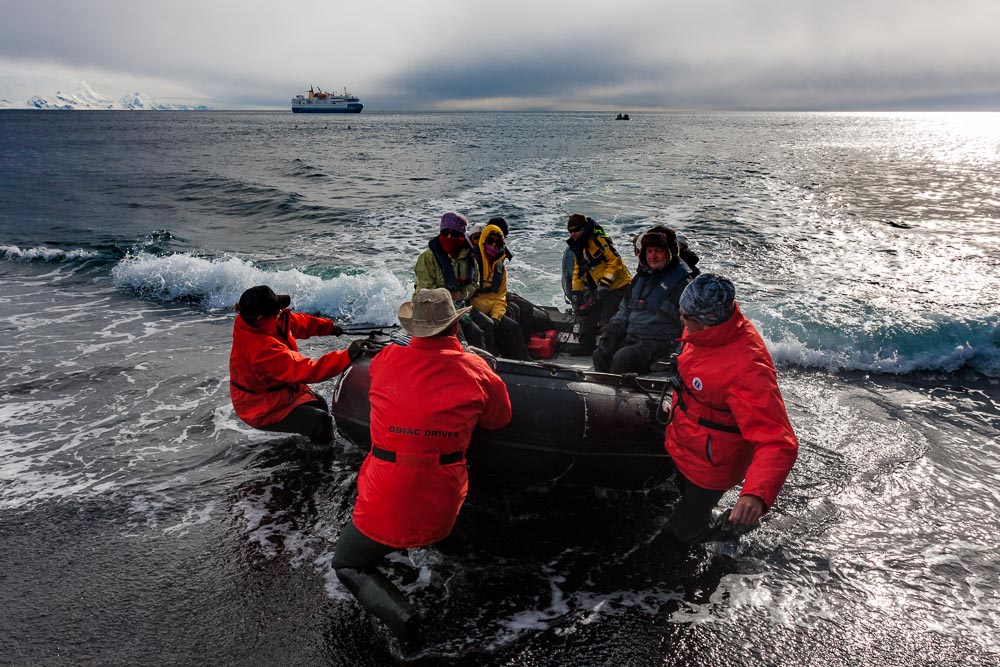 Landing with an inflatable boat can be challenging. In that case you need a trained and skilled team to do so. Sometimes it can be so challenging that the operation is cancelled. Therefore, it is very important to be with a very good team who can offer you the most for your time.
Landing with an inflatable boat can be challenging. In that case you need a trained and skilled team to do so. Sometimes it can be so challenging that the operation is cancelled. Therefore, it is very important to be with a very good team who can offer you the most for your time.
Antarctica by ship
Since Antarctica is surrounded by water, the most common way for anyone to reach this stunning place is by ship. There are three departures available: from South America, it takes only 1.5 or 2 days at sea to get to the Antarctic Peninsula (1000km or 600miles to cross the Drake passage); from Australia, it requires roughly five or six days at sea (2500km or 1600 miles); and from South Africa, this requires roughly eight or more days at sea (3000km or 1900 miles) but this option is only available to scientist and technical staff, and does not apply to travelers.
For practical reasons, comfort and cost, the most popular voyage is the one departing from South America, and crossing the Drake passage to the Antarctic Peninsula. This represents 98% of the voyages to Antarctica. On rare occasions, some companies offer the option to fly over the Drake passage and to embark on the ship once you are in Antarctica and fly out the same way. I will describe it after this section.
Most cruises depart from one of the gateway ports in southern South America, such as Ushuaia (Argentina), Punta Arenas (Chile) or Montevideo (Uruguay), to the scenic and wildlife rich Northern tip of the Antarctic Peninsula. These cruises often include visits to the nearby Falkland Islands (Islas Malvinas) and South Georgia. A limited number of cruises operate to the Ross Sea side of the continent departing from Hobart, Australia or Lyttelton or Bluff, New Zealand. Occasionally, a trip to the Peninsula will be offered that begins or ends in Cape Town or Port Elizabeth (South Africa), either at the start or end of the season as the ships are being repositioned for the Antarctic season.
Very few voyages start from Australia or New Zealand in the direction of the Ross Ice shelf. This one is, of course, much longer and far more costly. Some very rare voyages start from South America, visit the Antarctic Peninsula, then continue traveling eastward, with plans to reach some extremely remote islands and end in South Africa or sometimes travel as far as the Ross ice shelf before ending up in Australia! Naturally, these trips are the most adventurous, the most expensive, and the longest ones. They accrue a lot of days at sea and they are very risky (as there are a lot of landings cancelled due to bad weather or ice).
Of course, the size of your wallet will determine what you can afford or not. Once you have fixed a budget and timeframe for your trip, it’s time to choose the kind of ship you want. The size of the ship is the biggest factor to be taken into consideration. This will dictate your whole experience in the field.
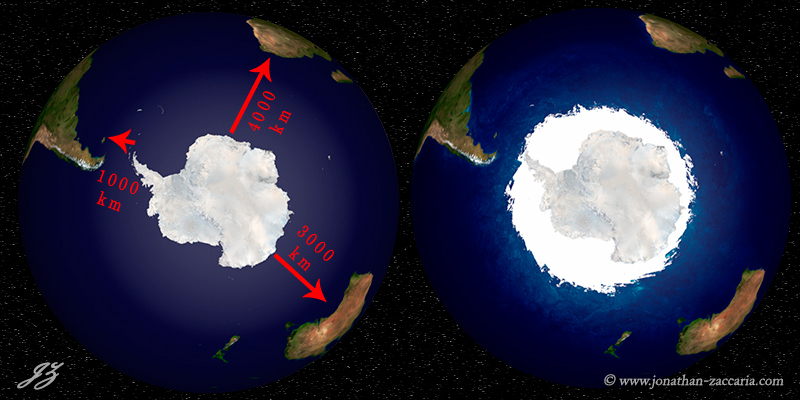 Antarctica is the most remote continent, isolated by the Southern Ocean. The shortest distance from other landmasses is the band of water between South America and the Antarctic peninsula called: The Drake Passage. For that reason, most of the traffic to reach Antarctica happens there.
Antarctica is the most remote continent, isolated by the Southern Ocean. The shortest distance from other landmasses is the band of water between South America and the Antarctic peninsula called: The Drake Passage. For that reason, most of the traffic to reach Antarctica happens there.
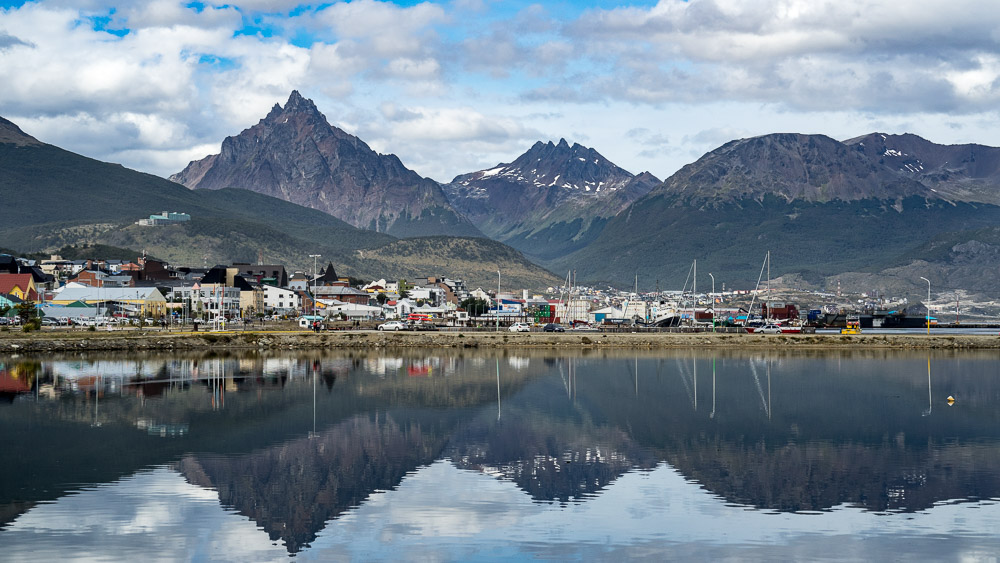 Ushuaia is the southernmost city in the world: the gateway to Antarctic trips. This is the most common place to depart towards the white continent.
Ushuaia is the southernmost city in the world: the gateway to Antarctic trips. This is the most common place to depart towards the white continent.
Ship cruise VS Expedition cruise
Cruise ship
These ships carry more than 500 passengers and offer to discover the Antarctic by “cruising only”. This means you stay aboard the vessel and enjoy the landscape and scenery from the outer decks. Excursions in Antarctica are NOT possible from these ships. This kind of trip is usually combined with some days to spend on land around Patagonia at the beginning or end of your trip.
- The pros:
- the price of the ticket (per day) is much lower
- the comfort aboard is really high
- The cons:
- you will “cruise only” since these ships are not allowed to bring their passengers ashore (for environmental protection purpose and safety)
- the ratio guides/passengers is lower, so you will not be very close to your guides
 "Cruise ship" means that you stay aboard and enjoy the scenery from the ship. Obviously, my preference, far and away, is the expedition cruise!
"Cruise ship" means that you stay aboard and enjoy the scenery from the ship. Obviously, my preference, far and away, is the expedition cruise!
Expedition cruise
An Expedition Cruise is a trip on a ship carrying less than 500 passengers. In these cases, passengers are allowed to land. We call these ships “Expedition Vessels” because they use small open boats to bring you ashore where there are no facilities to berth (no jetty, no wharf). Please note, in the Antarctic, it is not permitted to land more than 100 people at a time at the same spot. In some cases, other options are offered, like kayaking, diving, camping, mountaineering, Heli flights, etc. "Expedition Cruise" also means that the itinerary is flexible and weather dependent. To be honest, most companies that travel to Antarctica must keep their itinerary more or less flexible. Some try to do everything possible to stick to the original plan, while for others, there is no plan at all! This is, of course, the best option. Flexibility offers to give you the best experience possible. However, this also requires a lot of flexibility and adaptability from the passengers.
 "Expedition cruise" means that you will be able to take excursions off of the ship. You are closer to the elements, the wildlife, the ice, etc... It also means that you are more flexible. Of course, the smaller the boat, the more flexible the itinerary, the more time you spend outside, the better!
"Expedition cruise" means that you will be able to take excursions off of the ship. You are closer to the elements, the wildlife, the ice, etc... It also means that you are more flexible. Of course, the smaller the boat, the more flexible the itinerary, the more time you spend outside, the better!
201 to 500 passengers
Many options are proposed on these vessels. Some ships just “cruise” and landing is only available at additional cost; while other ships stay at the same place the whole day and organize several rotations of 100 people ashore at a time. (ex: group A from 08:00 to 10:00, group B from 10:00 to 12:00, etc...)
- The pros:
- the price is lower than those of smaller ships
- the comfort is high
- The cons:
- you do not spend a lot of time ashore
- In the case that several groups rotate their time to go ashore, the ship will need to stay at the same place the whole day.
- you will visit less places
- not all the visitor sites in the Antarctic are open for this size of ship
101 to 200 passengers
Starting with vessels of this size, we start to experience the true “expedition style” cruising of small size ships. Of course, no more than 100 passengers can be ashore at a time at the same place, but the dynamic is already there: you are closer to your guide, you will visit more places, and you will likely spend more time outside. Usually two groups of 100 people are made. While one is ashore, the other one can wait for their turn on the ship or take a small boat cruise in the meantime, we call this a “split landing”.
- The pros:
- not as expensive as smaller ships under 100 passenger capacities
- you can visit more than one place in one day
- you spend more time outside per day
- you are closer to your guides
- all visitor sites in the antarctic are open to this ship’s capacity
- The cons:
- still less time ashore than smaller ships
13 to 100 passengers
In the “Expedition Ship” business, we call them “small ships”, because their capacity is under 100 passengers. All passengers can get off the ship at once for boat cruising or landings. It is easier to provide the same experience to everyone, and it provides the highest level of flexibility.
- The pros:
- all visitor sites in the antarctic are open to this ship’s capacity
- it is easier to provide the same experience for everyone as everyone can go out at one time
- twice as much time outside in comparison with a 200-passenger vessel.
- you are very close to your guides, as you will be sharing meals with them several times a day
- flexibility allows you to be capable to change itinerary depending on weather, wildlife or ice conditions
- the highest possibility of improvisation when something great is happening outside: a small boat cruise or a landing can be decided right on the spot
- more options are available (kayaking, camping, skiing, diving, etc...)
- The cons:
- more expensive than the larger ships
- no entertainment aboard the vessel in comparison to what is offered on big cruise lines
- less luxury and less public areas
Less than 13 passengers
We’ll call them “yachts”. Finally, the real adventure! On such a journey, you have two kinds of vessels: motorboats (usually taking up to 12 passengers) or sailing boats (taking between 3 and 12 guests). You should be aware that sailing boats mostly travel with their engines and not with sails (you cannot use sails with fair winds- which is the kind of wind you want, and with too much wind, you need to tack, which slows your way down a lot).
These tiny ships are the most flexible of all. They do not travel as fast as a bigger ship, and they usually spend more days around the Antarctic than bigger ones. Such trips are only offered around the Antarctic peninsula for obvious reasons.
- The pros:
- you feel closer to the nature and environment
- you will definitely be really close to your guide, as you typically only have one guide onboard, sometimes two
- you can go anywhere, really. Places where bigger ships will never go.
- a lot of options are proposed: trips for divers, for skiing, for mountaineering, for photographers...
- you are able to stay longer outdoors
- The cons:
- less comfort and amenities onboard
- slower speed cruising
- it is more difficult to cope with bad weather
- there are less personnel to pamper you
- there are less personnel to assist you ashore and create groups for different levels of activities
Antarctica by plane: fly and cruise option VS land based trip only
Air-cruise
This is a unique option for those who do not have a lot of time for their holidays, or if you are prone to feeling sea sick! In fact, you will fly over the Antarctic ocean and embark your ship in Antarctic waters. After a few days traveling in Antarctica, you will fly out the same way. For practical reasons, this option only exists to visit the Antarctic peninsula aboard small expedition vessels, and is operated by very few companies. The home airport is Punta Arenas (Chile) and the duration of the flight is two hours. You will land on a runway operated by the Chilean Air Force in the South Shetland Islands. From there, some companies also offer half-day excursions on the South Shetlands before heading back without cruising. I find it such a pity, to make all possible efforts to be there, without proceeding further South! Otherwise, after 15 mins walking down the runway, you'll embark your ship for 3, 5 or 7 days depending on the voyage.
- The pros:
- extremely comfortable and efficient way to reach Antarctica
- fast! A 2h flight instead of a minimum of 1.5 or 2 days at sea
- no bad motion sickness
- The cons:
- the departure flight cannot be guaranteed, as it is very weather dependent. You are in stand-by mode until it takes off. This may take several hours, and, in some cases more than a day. (Companies are really clear about it and some have a refund policy.)
- on rare occasions (it is rare, but it does happen), the flight is canceled at the last minute: you won’t get to visit Antarctica
- the price is more expensive due to the charter flight to the Antarctic!
 "Air-cruise" is when you fly over the Drake passage and you embark the ship which is waiting for you in the Antarctic peninsula. This aircraft lands on the Chilean runway at Frei station on King George island in the South Shetland islands.
"Air-cruise" is when you fly over the Drake passage and you embark the ship which is waiting for you in the Antarctic peninsula. This aircraft lands on the Chilean runway at Frei station on King George island in the South Shetland islands.
Land based trip
And last but not least, land based trips are the most expensive way to go to Antarctica, but this will provide you a totally different perspective and experience. You will not see icebergs, whales, ice cliffs, glaciers... you will be living it! You will live the silence and vastness of its interior by skiing, kiting and camping to reach several destinations: a summit, the south geographic pole or why not an Emperor penguin colony.
On these excursions, several options are possible.
You can fly out from Cape Town, South Africa with an Ilyushin 76 TD-90 and land on the Novo Runway close to the Russian Novolazarevskaya Station. From there, hiking and mountaineering options are very feasible. However, you must be a well-trained mountaineer.
You can take off from Punta Arenas (Chile) with an Ilyushin, and land quite South in the Antarctic peninsula at Union Glacier. From there, you can camp and reach other destinations with smaller aircraft like DC3, Casa or twin otter. You can fly to the South Geographic Pole, home to the American Amundsen-Scott Station. Or you can fly to 89°C South and ski the last degree (it takes roughly one week). You can fly to the Ronne ice shelf, and visit an Emperor penguin colony. Otherwise, you can stay there and prepare yourself to climb the seventh submit: Mount Vinson (4892m or 16049ft)!
Fly only
Some airlines in Australia offer to take off from Hobart to fly over Antarctica: they "visit" the coastline by air... The plane flies low (as low as possibly allowed by the regulations) making some loops over area of interests. You will receive comments from the speakers in the aircraft. This kind of trip last 7 or 8 hours, or as needed, to reach the continent before flying back... Since the price is also quite expensive, I recommend you choose another option!
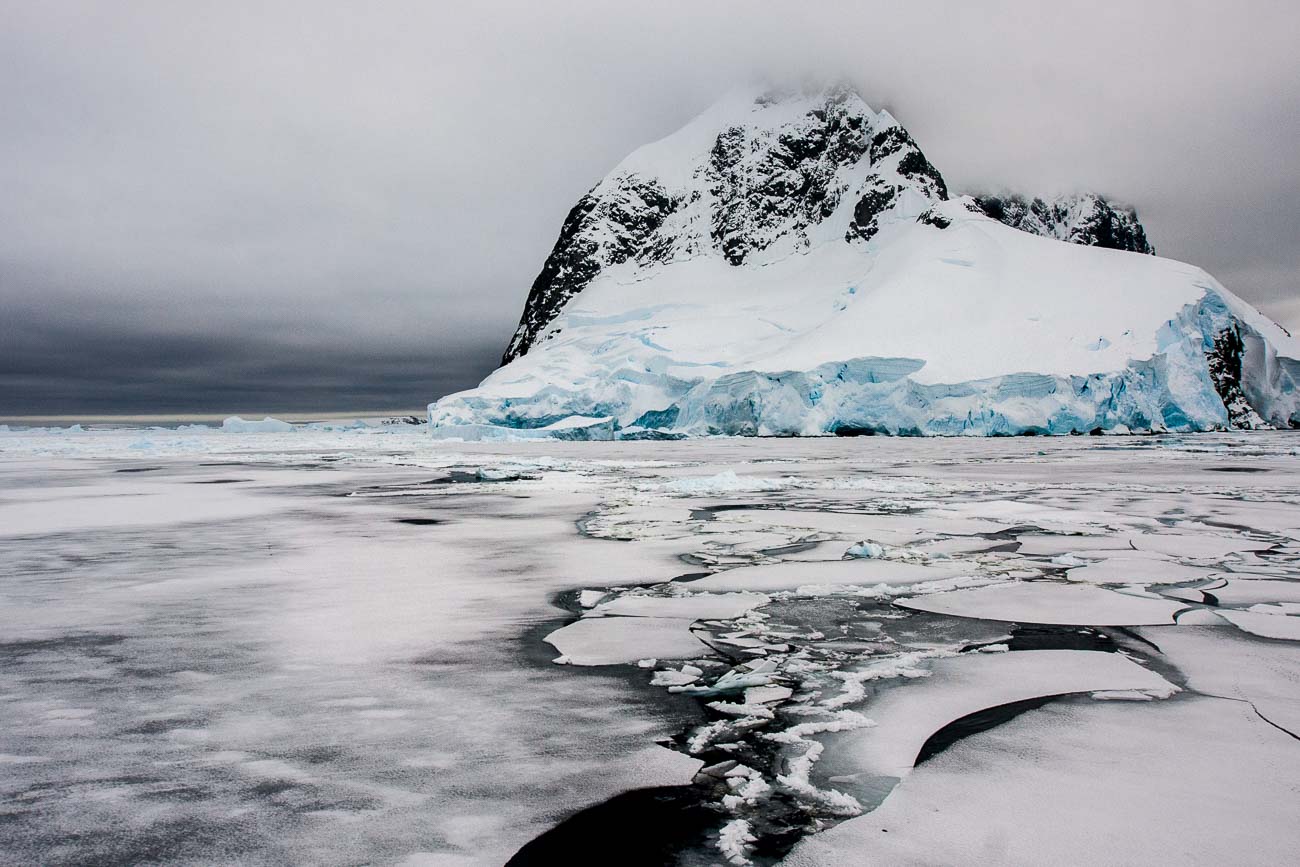






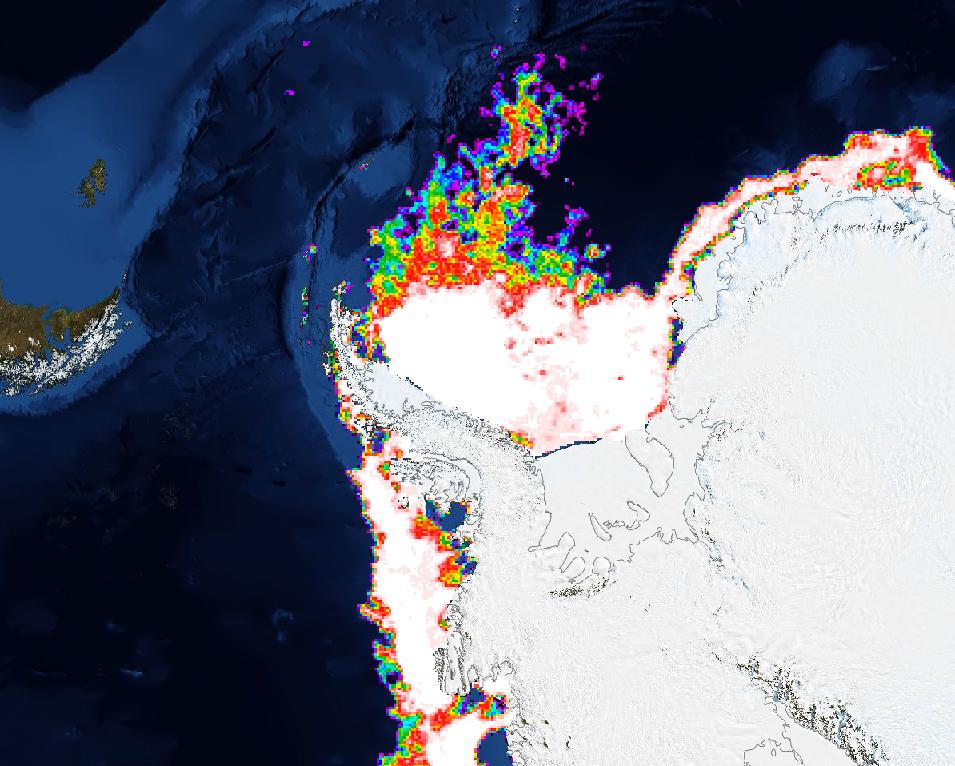

 "Cruise ship" means that you stay aboard and enjoy the scenery from the ship. Obviously, my preference, far and away, is the expedition cruise!
"Cruise ship" means that you stay aboard and enjoy the scenery from the ship. Obviously, my preference, far and away, is the expedition cruise! "Expedition cruise" means that you will be able to take excursions off of the ship. You are closer to the elements, the wildlife, the ice, etc... It also means that you are more flexible. Of course, the smaller the boat, the more flexible the itinerary, the more time you spend outside, the better!
"Expedition cruise" means that you will be able to take excursions off of the ship. You are closer to the elements, the wildlife, the ice, etc... It also means that you are more flexible. Of course, the smaller the boat, the more flexible the itinerary, the more time you spend outside, the better!